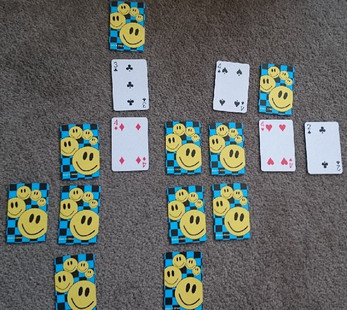Happy Graphs! ☺
A downloadable game family
Hi there! ☺
The following is a structure/system/framework I've designed that yields a variety of solitaire or cooperative puzzle card games, meant to be played with a standard 52-card deck! I'll go over how the cards work with each other first, then give some examples of what players can do with that!
Here's the basics:
1. Every card has a number. We'll use 1-4 (ace to four). Suit doesn't matter.
... .4. ...
2. The number represents how many connections it wants. We have a 4 here,
so it wants 4 connections.
.... .42. ....
3. You can only play cards next to cards that have already been played.
- Default: this means up, down, left, or right of another card.
- Each time you place a card next to another card, they both gain a connection!
- We played a 2 next to the 4, so they both have one connection.
- The 4 has 1 of 4 desired connections, the 2 has 1 of 2.
..A. ..☺. .42. => .4☺. .... ....
4. When a card reaches its desired number of connections, it's happy!
- I usually represent this by turning the card over.
- We played an Ace above the 2.
- The Ace only needed one connection, so it's immediately happy.
- The 2 got both of its connections, so it's also happy!
- Default: diagonals don't count, so the 4 still has 1 of 4 connections.
..☺. .4☺. ....
5. Scoring: Default: The player group's score at the end is like golf scores: the lower the better. At the end, you count the number of cards that aren't yet happy, and that's your score.
- If the game ended here, our score would be 1, because the 4 isn't happy yet but the other two are.
. A? ☺ . . 4 ☺ . . . . .
5. You can't ever play a card where it would give any card more connections than it wants. In the above example,
- We can't play an Ace above the 4 because it would immediately have 2 connections, and it can only have up to one.
- We actually can't play any card there, because it's next to a card that's already happy (and thus can't have any more connections).
- You can imagine that there's a wall occupying spaces around all of the cards that are currently happy:
.... ..X. ..☺. .X☺X .4☺. => .4☺X .... ..X.
- Note: This means that some plays can prevent cards from ever being completed! Because an Ace was played up and right of the 4, now nothing can be played in the slot above the 4, so the 4 can never be completed.
Aaand that's essentially the system! I've tested a wide variety of styles based on this, but this is the core of all of them. To finish up a single set of rules:
Default:
All of the above rules, plus the following:
6. Use A-4 of each suit in a single deck of cards (so total 16 cards).
7. Hand size:
Players Hand Size 1 1 2 3 3-6 2 7-16* 1
*If you have more than 16 people who want to play, grab another deck's A-4 cards and keep going! (still hand size 1)
8. Every time you play a card, draw a card, until the deck runs out.
9. A turn consists of playing a card and (if possible) drawing a card.
10. The game ends when there are no more cards to be played.
11. If it is impossible to play a card adjacent to another card, a new group of cards is started by the current player (the one who hasn't yet played).
The above are just a simple set of rules that can be used. Here are a few variations:
8-Way:
As above, but using A-8 and counting diagonals/corners as well as sides.
The following is an example of a self-satisfied set of cards — everything that's there is happy:
...
.....A.
.3543..
.586..
.475..
..43..
......
6-Way:
This uses A-6 and a hex grid system. Thinking about the top half and bottom half of a card, you can place cards up, down, up-left. up-right, down-left, and down-right of another card. You can't actually place cards directly left or right of each other.
In this example, the lines show how cards can connect up and down, and block connections left-right:
. . A . | . | . . | 3 | 2 . 2 | 4 | . . | 5 | . . | 3 | . . 2 | A .
Another way to look at it is the next example, which shows each card's top half and bottom half:
. . A . . . . A . . . 3 . 2 . . 2 3 4 2 . . 2 5 4 . . . . 5 3 . . . . 2 3 . . . 2 .
Pure Puzzle:
In this variant, simply look at all cards face up and try to arrange them into a perfect score (all cards are happy!).
Thanks for reading, and feel free to comment or email if you have any observations or ideas arising from these that you'd like to share! Feel free to send me rules you come up with and I can add them here and credit you!
Credits!
Playtesters
Shepherd Cameron (@pitchipsy)
Jonathan Parsons
Claire Barton (@claire-b)
Johnathan Ying
Keana Almario (@kishifishy)
Nancie Moon
Diego Francisco
Nate Brengle
Paige Ashlynn (@mxashlynn)
Jennifer Stienstra (@thefantasticjen)
Kefu Lu
Lillian Everette H
| Status | Released |
| Category | Physical game |
| Rating | Rated 5.0 out of 5 stars (2 total ratings) |
| Author | Caidence |
| Genre | Card Game |
| Tags | Multiplayer |
Download
Click download now to get access to the following files:
